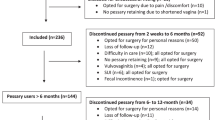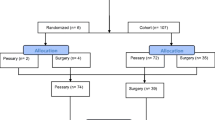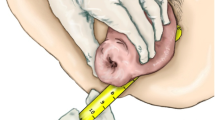Abstract
Purpose
To estimate the optimal definition of successful pessary use and the long-term success rate of the pessary as well as the complications and factors associated with continued pessary use.
Methods
Consecutive patients who had symptomatic stage III/IV POP were enrolled. The degrees of POP were assessed by POP-Q. All patients completed the PFIQ-7 questionnaire before pessary use. For the 1-week, 1-month, 3-month, 6-month, 1-year and 3-year follow-up assessments, patients visited the clinic for an examination and to complete the questionnaire. SPSS 18.0 was used for the data analysis. Wilcoxon's signed-rank test was performed to estimate the change in PFIQ-7 scores before and after pessary use. Logistic regression was performed to identify the factors associated with the duration of pessary use.
Results
A total of 60 subjects (average age 68.93 ± 8.98 years) were enrolled. The 3-year success rate of the pessary was 63.33%. The PFIQ-7 score in the 1-month follow-up was significantly decreased (16.22 ± 12.81 vs 1.39 ± 3.39, P = 0.000). During the follow-up, none of the patients experienced any severe complications, and the rate of vaginal erosion was 20% (12/60). The PFIQ-7 score in the 1-month follow-up decreased more than 50% and was associated with continuous pessary use [OR 20.75, P = 0.027, 95% CI (2.28, 189.27)].
Conclusions
Successful pessary use can be defined as fitting for longer than 3 months. The PFIQ-7 scores should be focused on during the follow-up. The treatment should be changed if the scores decrease less than 50% in the 1-month follow-up.

Similar content being viewed by others
References
Olsen AL, Smith VJ, Bergstrom JO et al (1997) Epidemiology of surgically managed pelvic organ prolapse and urinary incontinence. Obstet Gynecol 89:501–506
Atnip SD (2009) Pessary use and management for pelvic organ prolapse. Obstet Gynecol Clin North Am 36:541–563
Cundiff GW, Weidner AC, Visco AC et al (2000) A survey of pessary use by members of the American urogynecologic society. Obstet Gynecol 95:931–935
Abdool Z, Thakar R, Sultan AH et al (2011) Prospective evaluation of outcome of vaginal pessaries versus surgery in women with symptomatic pelvic organ prolapse. Int Urogynecol J 22:273–278
Friedman S, Sandhu KS, Wang C et al (2010) Factors influencing long-term pessary use. Int Urogynecol J 21:673–678
Sarma S, Ying T, Moore KH (2009) Long-term vaginal ring pessary use: discontinuation rates and adverse events. BJOG 116:1715–1721
Hanson LA, Schulz JA, Flood CG et al (2006) Vaginal pessaries in managing women with pelvic organ prolapse and urinary incontinence: patient characteristics and factors contributing to success. Int Urogynecol J 17:155–159
Mutone MF, Terry C, Hale DS et al (2005) Factors which influence the short-term success of pessary management of pelvic organ prolapse. Am J Obstet Gynecol 193:89–94
Clemons JL, Aguilar VC, Tillinghast TA et al (2004) Risk factors associated with an unsuccessful pessary fitting trial in women with pelvic organ prolapse. Am J Obstet Gynecol 190:345–350
Maito JM, Quam ZA, Craig E et al (2006) Predictors of successful pessary fitting and continued use in a nurse-midwifery pessary clinic. J Midwifery Women’s Health 51:78–84
Li B, Zhu L, Xu T et al (2012) The optimal threshold values for the severity of urinary incontinence based on the 1-h pad test. Int J Gynaecol Obstet 118:117–119
Clemons JL, Aguilar VC, Sokol ER et al (2004) Patient characteristics that are associated with continued pessary use versus surgery after 1 year. Am J Obstet Gynecol 191:159–164
Zhu L, Yu S, Xu T et al (2011) Chinese validation of the pelvic floor impact questionnaire short form. Menopause 18:1030–1033
Jones K, Yang L, Lowder JL (2008) Effect of pessary Use on genital hiatus measurements in women with pelvic organ prolapse. Obstet Gynecol 112:630–636
Ding J, Chen C, Song XC et al (2016) Changes in prolapse and urinary symptoms after successful fitting of a ring pessary with support in women with advanced pelvic organ prolapse: a prospective study. Urology 87:70–75
Barnes NM, Dmochowski RR, Park R et al (2002) Pubovaginal sling and pelvic prolapse repair in women with occult stress urinary incontinence: effect on postoperative emptying and voiding symptoms. Urology 59:856–860
Klutke JJ, Ramos S (2000) Urodynamic outcome after surgery for severe prolapse and potential stress incontinence. Am J Obstet Gynecol 182:1378–1381
Fernando RJ, Thakar R, Sultan AH et al (2006) Effect of vaginal pessaries on symptoms associated with pelvic organ prolapse. Obstet Gynecol 108:93–99
Komesu YM, Rogers RG, Rode MA et al (2007) Pelvic floor symptom changes in pessary users. Am J Obstet Gynecol 197:620.e1–6
Acknowledgements
This work was supported by grants from the National Natural Science Foundation of China (81501238).
Funding
This work was supported by grants from the National Natural Science Foundation of China (81501238).
Author information
Authors and Affiliations
Contributions
BL: project development, data collection, manuscript writing. QHC: project development, data analysis; manuscript writing. JZ: data collection, manuscript writing. CGY: data collection, manuscript editing. LZ: data collection, data analysis. LHC: project development, manuscript editing.
Corresponding author
Ethics declarations
Conflict of interest
All authors declare that they have no conflict of interest.
Ethical approval
All procedures performed in studies involving human participants were in accordance with the ethical standards of the institutional and/or national research committee and with the 1964 Helsinki declaration and its later amendments or comparable ethical standards. This study was approved by the institutional ethics committee of Shaanxi provincial people’s hospital. All participants gave the verbal and signed consent.
Informed consent
Informed consent was obtained from all individual participants included in the study.
Additional information
Publisher's Note
Springer Nature remains neutral with regard to jurisdictional claims in published maps and institutional affiliations.
Rights and permissions
About this article
Cite this article
Li, B., Chen, Q., Zhang, J. et al. A prospective study of pessary use for severe pelvic organ prolapse: 3-year follow-up outcomes. Arch Gynecol Obstet 301, 1213–1218 (2020). https://doi.org/10.1007/s00404-020-05526-1
Received:
Accepted:
Published:
Issue Date:
DOI: https://doi.org/10.1007/s00404-020-05526-1




